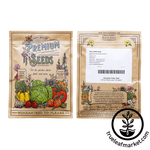
70-84 days. Non-GMO, Heirloom White Swan Echinacea Herb Garden Seed from True Leaf Market. Echinacea purpurea. Echinacea grows as a warm perennial native to North America. Cultivated in 1987, this wildflower is one of the original Purple Echinacea varieties and grows similarly to its pink-colored coneflower relatives. 25,000 seeds/ounce.









